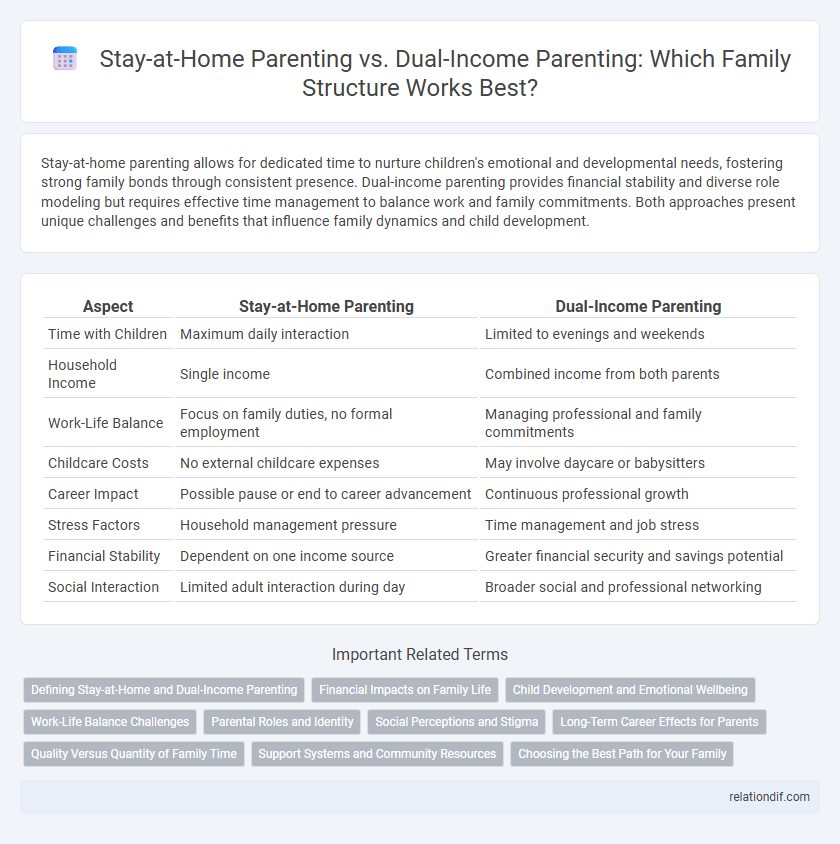Stay-at-home parenting allows for dedicated time to nurture children's emotional and developmental needs, fostering strong family bonds through consistent presence. Dual-income parenting provides financial stability and diverse role modeling but requires effective time management to balance work and family commitments. Both approaches present unique challenges and benefits that influence family dynamics and child development.
Table of Comparison
| Aspect | Stay-at-Home Parenting | Dual-Income Parenting |
|---|---|---|
| Time with Children | Maximum daily interaction | Limited to evenings and weekends |
| Household Income | Single income | Combined income from both parents |
| Work-Life Balance | Focus on family duties, no formal employment | Managing professional and family commitments |
| Childcare Costs | No external childcare expenses | May involve daycare or babysitters |
| Career Impact | Possible pause or end to career advancement | Continuous professional growth |
| Stress Factors | Household management pressure | Time management and job stress |
| Financial Stability | Dependent on one income source | Greater financial security and savings potential |
| Social Interaction | Limited adult interaction during day | Broader social and professional networking |
Defining Stay-at-Home and Dual-Income Parenting
Stay-at-home parenting involves one parent dedicating full-time to childcare and household responsibilities, foregoing external employment to focus on the family's daily needs. Dual-income parenting refers to both parents engaging in paid employment, sharing financial responsibilities while balancing professional and family life. This parenting dynamic shapes family routines, resource allocation, and the distribution of caregiving roles within the household.
Financial Impacts on Family Life
Stay-at-home parenting often reduces immediate household income, impacting savings growth and retirement contributions but can lower childcare expenses significantly. Dual-income parenting typically enhances overall financial stability and supports higher discretionary spending while incurring additional costs such as daycare and transportation. Balancing these financial impacts requires evaluating long-term benefits of parental involvement against increased economic resources and expenses in dual-income families.
Child Development and Emotional Wellbeing
Stay-at-home parenting allows for more consistent emotional support and personalized attention, fostering secure attachment and early cognitive development in children. Dual-income parenting often necessitates balancing work and family time, which can encourage children's social independence and adaptability but may reduce direct parental interaction. Research indicates that the quality of parent-child interactions, rather than the parenting model itself, is the key determinant of positive emotional wellbeing and developmental outcomes.
Work-Life Balance Challenges
Stay-at-home parenting often faces challenges in maintaining personal identity and financial independence, while dual-income parenting struggles with time management and childcare coordination. Work-life balance issues in dual-income families include increased stress due to juggling career demands and family responsibilities simultaneously. Effective strategies for both approaches involve setting boundaries, prioritizing quality family time, and utilizing support networks to reduce burnout and improve overall well-being.
Parental Roles and Identity
Stay-at-home parenting often centers on the caregiver's identity deeply intertwined with child-rearing and household management, fostering primary nurturing roles that shape family dynamics. Dual-income parenting typically requires balancing professional responsibilities with shared caregiving duties, influencing parental roles by integrating economic providers' identities with active involvement in child development. Both models impact parental identity formation differently, highlighting the evolving nature of family roles in contemporary society.
Social Perceptions and Stigma
Stay-at-home parenting often faces social perceptions that underestimate the economic and emotional contributions of caregivers, with stigma suggesting a lack of ambition or financial dependence. Dual-income parenting is frequently viewed as more progressive and responsible, yet it can attract criticism for perceived neglect of familial responsibilities and diminished child-parent bonding. These contrasting societal attitudes influence family dynamics and parental self-esteem, shaping decisions beyond economic factors.
Long-Term Career Effects for Parents
Stay-at-home parenting often results in career interruptions that may lead to skill gaps, slower promotions, and reduced lifetime earnings, impacting long-term professional growth. In contrast, dual-income parenting supports continuous career development but can increase stress and work-life balance challenges, influencing job satisfaction and productivity. Employers increasingly recognize flexible work arrangements to mitigate long-term career drawbacks for both parenting styles.
Quality Versus Quantity of Family Time
Stay-at-home parenting often emphasizes quality time through consistent daily interactions and hands-on involvement in children's routines, fostering deeper emotional bonds and personalized care. Dual-income parenting may limit quantity of time but can enhance quality by encouraging focused, meaningful activities during shared moments, as well as providing financial resources that support enriching family experiences. Research highlights that emotional connection and engagement during family time significantly impact child development, regardless of overall duration spent together.
Support Systems and Community Resources
Stay-at-home parenting benefits from local support networks such as parent groups, community centers, and childcare co-ops that provide social interaction and shared responsibilities. Dual-income families often rely more heavily on formal childcare services, after-school programs, and employer-sponsored family support initiatives to balance work and parenting duties. Access to flexible work schedules, family leave policies, and community resources greatly influences the effectiveness of both parenting arrangements in promoting child development and parental well-being.
Choosing the Best Path for Your Family
Stay-at-home parenting allows for direct, consistent involvement in child development, fostering emotional security and personalized attention. Dual-income parenting provides financial stability and opportunities for career growth while requiring effective time management to balance work and family roles. Choosing the best path depends on a family's unique priorities, resources, and values, ensuring alignment with long-term well-being and household harmony.
stay-at-home parenting vs dual-income parenting Infographic

 relationdif.com
relationdif.com